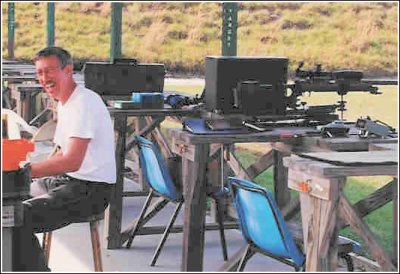Barrel Break-In Procedure

With any premium barrel that has been finish lapped (such
as a Krieger Barrel), the lay or direction of the finish is in the
direction of the bullet travel, so fouling is minimal. This is
true of any properly finish-lapped barrel regardless of how it is
rifled. If it is not finish-lapped, there will be reamer marks
left in the bore that are directly across the direction of the bullet
travel. This occurs even in a button-rifled barrel as the button
cannot completely iron out these reamer marks.
Because the lay of the finish is in the direction
of the bullet travel, very little is done to the bore during break-in,
but the throat is another story. When your barrel is chambered,
there are reamer marks left in the throat that are across the lands,
i.e. across the direction of the bullet travel. In a new barrel
they are very distinct; much like the teeth on a very fine file.
When the bullet is forced into the throat, copper dust is released into
the gas which at this temperature and pressure is actually a plasma.
This copper dust is vaporized in the gas and is carried down the
barrel. As the gas expands and cools, the copper comes out of
suspension and is deposited in the bore. This makes it appear as
if the source of the fouling is the bore, when it is actually for the
most part the new throat. If this copper is allowed to stay in
the bore, and subsequent bullets and deposits are fired over it; copper
which adheres well to itself, will build up quickly and may become
difficult to remove. So . . . when we break in a barrel, our goal is to get the throat polished without allowing copper to build
up in the bore. This is the reason for the "fire-one-shot-and-clean" procedure.
Each barrel will vary slightly as to how many
rounds it will take to break in. This is because of things like
machinability of the steel, steel chemistry, or the condition of the
chambering reamer. For example a chrome moly barrel may take
longer to break in than stainless steel, because it is more abrasion
resistant, even though it might be the same hardness. Also,
copper will stick to chrome moly better than stainless steel, so it
will usually show a little more "color" if you are using a chemical
cleaner. Rimfire barrels can take an extremely long time to
break in . . .
sometimes requiring several hundred rounds or more. But,
cleaning intervals can be extended to every 25-50 rounds. The
break-in procedure procedures are really the same except for the
frequency of the cleanings. Remember the goal is to get or keep
the barrel clean while polishing out the throat.
The
best way to break-in a new barrel is to observe when the fouling
becomes reduced. This is better than believing that there is a
set number of "shoot and clean" cycles. Many customers report
almost no fouling after the first few shots, and more break-in would be
pointless. Conversely, if more "shoot and clean" cycles are
required, a set number would not solve that problem either.
Besides, this break-in procedure is not a completely harmless
operation, so it should be done carefully and no more than necessary.
There is no
hard and fast rule about barrel break-in procedure, and this is only
meant to be a guide to "break-in" based on our experience. Some
barrel conditions (chamber, bullet, primer, powder, pressure, velocity
etc.) may require more shoot-and-clean cycles than others. It is
a good idea to just observe what the barrel is telling you with its
fouling pattern. Once your barrel is broken in, there is no need
to continue breaking it in.
You should Initially perform the
shoot-one-shot-and-clean cycle five times. If copper fouling
isn't reduced, fire one shot (5 more times) and so on until fouling
begins to drop off. At that point shoot three shots before
cleaning and observe. If fouling is reduced, fire five shots
before cleaning.
Stainless Chrome moly Barrels
- Fire one shot, then clean your barrel. (Repeat this step 5 to 25 times.)
- Fire three shots, then clean your barrel. (Repeat this step 1 or 2 times.)
- Fire five shots, then clean your barrel and you're done.
Stainless Steel Barrels
- Fire one shot, then clean your barrel. (Repeat this step 5 times.)
- Fire three shots, then clean your barrel.
- Fire five shots, then clean your barrel and you're done.
